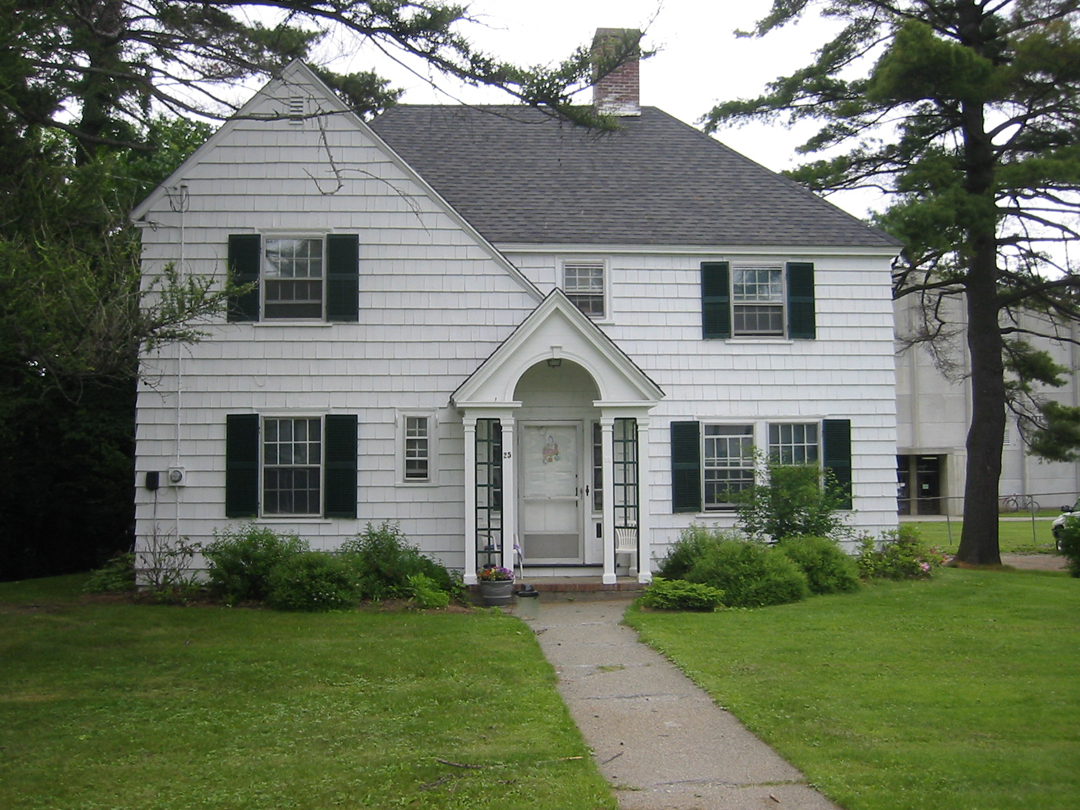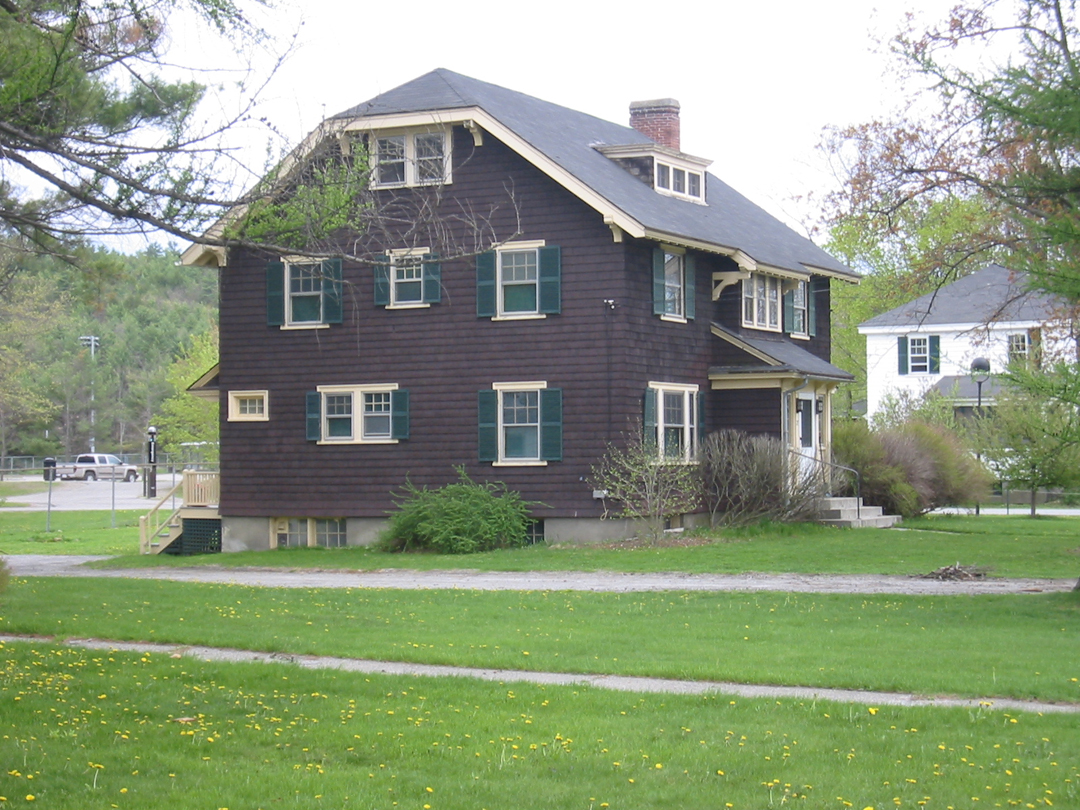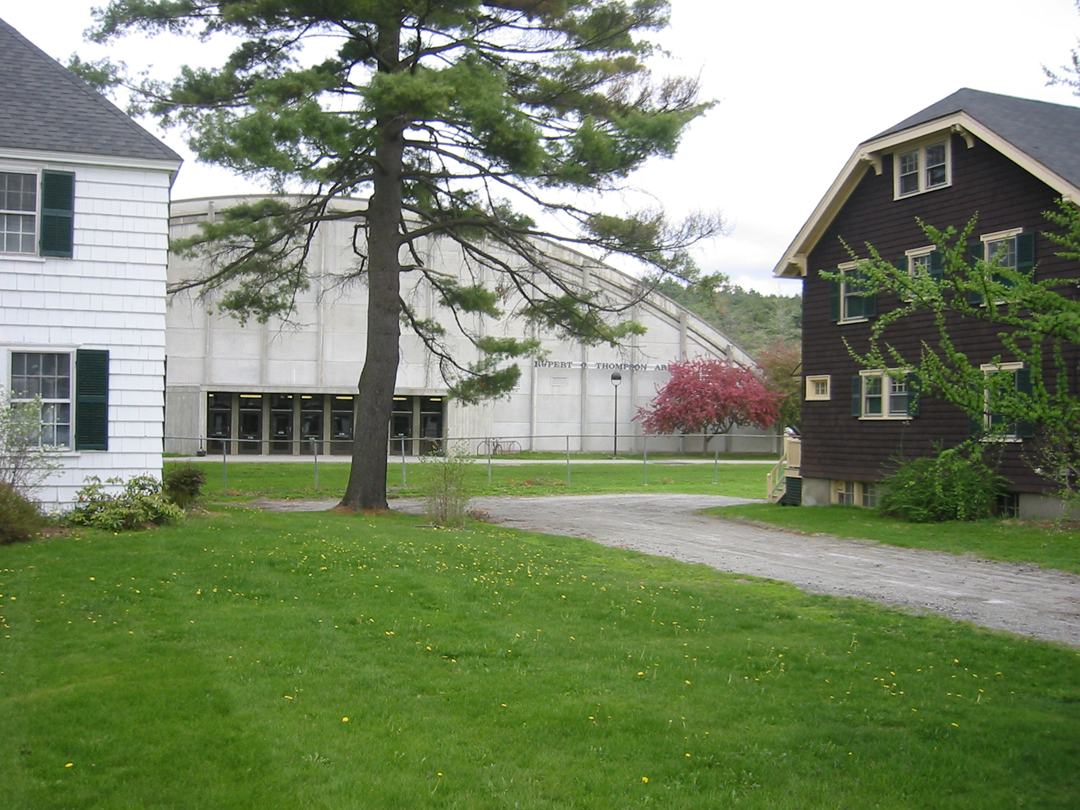The school recently celebrated the Roth Center’s first decade. Vox, The Dartmouth.
Category Archives: History
Coffee-table book on the DOC
The College might publish a coffee-table book in 2009 with all of the Winter Carnival posters in commemoration of the Dartmouth Outing
Club’s Centennial, according to The Dartmouth, citing Archivist Peter Carini.
“Big Green” nickname contemporary with “Indians”
So “Indians” is a relatively recent nickname of the 1918-1925 period, and “Green,” at least as adjective, may be as early as the 1860s, when the color was selected. When did “the Big Green” emerge as a complete nickname?
The words “big Green” began appearing in the New York Times by 1911, but only as adjectives describing nouns such as “team,” “line,” “eleven,” “players,” “machine,” “skaters,” “five,” etc. The phrase applied not just to football but all sports, apparently. The most frequent use was “the big Green team” (1911), but “the big Green line” (1911) also was popular. Writers also used “Hanoverians” and many other terms. A September 9, 1916 article from the Fort Wayne News wrote stated that it was “necessary to uphold the fame of the ‘Big Green’ team”; the Atlanta Constitution wrote in a November 20, 1921 headline that “Dartmouth’s Big Green Machine Arrives Early.” This use of “big Green” as an adjective continued into the 1940s.
When was “Big Green” used as a noun phrase on its own? In the shorthand phrasing of newspaper headlines, it appeared by 1916. A November 11, 1916 article in the Times uses the headline “Big Green Practices Here,” for example. The first line of the article, however, used the earlier form when it stated that “The big Green team from Dartmouth arrived here yesterday . . .”
The first use of “Big Green” as we know it today might be in the Times of October 28, 1923, where the article stated that “the Big Green began its march for its first touchdown.” The following football seasons of the early 1920s saw many such uses: “the Big Green, passed [. . .] its way through a stubborn Chicago team here today” (Decatur Review (November 14, 1925)), etc.
Strasenburgh’s past
The Class of 1978 Life Sciences Building is taking the place of Strasenburgh Hall, a cramped Medical School office building. Strasenburgh was built as a dormitory, and for that reason it was the only building on the School’s “original” (1950-1980) campus not designed by SBRA: the dormitory, like its Tuck School counterpart Buchanan Hall, was designed by the consulting architects of the College, Campbell Aldrich & Nulty.
Dartmouth Medicine magazine (Winter 2006) has an article by Jennifer Durgin on Strasenburgh’s past, and it includes an excellent aerial photo of the medical campus. Strasenburgh’s small scale and busy faceting made it one of the least unappealing buildings of the group.
Ledyard article
Edward Gray’s article “American Arriviste” in Humanities 28:6 (November/December 2007) is about John Ledyard.
Lost colleges of the University of Coimbra
The Collegiate Way links to an article in Portuguese on the University of Coimbra’s lost colleges (translation by Google). The university claims to be the oldest in Portugal, founded in 1290 (Wikipedia), and once had more than two dozen colleges (map) founded between 1527 and 1779. They were dissolved in 1834, however, and now some of their surviving buildings house university departments.
—–
[Update 06.13.2015: Broken link to map replaced.]
[Update 01.05.2013: Broken links to article and translation removed.]
College buys two Larson houses for campus groups
Dartmouth’s design office updated its complete list of projects in December (pdf). Renovations of New Hampshire Hall and the Inn are in the works, along with the creation or upgrading of a multipurpose sports field.
Dartmouth has also bought and is renovating the neighboring houses at 25 and 27 South Park Street and plans to rent each one to a sorority. Alpha Xi Delta will move from Webster Avenue, where it has rented the Beta Theta Pi House, and Alpha Phi will occupy a house for the first time, The Dartmouth reports. Both have been identified as designs of Jens Larson.
This is the front (west) facade of number 25.
This is number 27. To the right at number 29 is Fire & Skoal, also a Larson design.
The houses screen Thompson Arena.
More on coats-of-arms granted to U.S. schools
A 2005 presentation by Henry Bedingfeld, “English Grants of Arms in America,” summarized by the College of Arms Foundation, shows the surprising extent of the honorary grants of arms to institutions in the U.S. following a 1960 decision to begin making such grants. The list includes a number of schools:
- Georgia State College (1968)
- Hampden-Sydney College, Virginia (1976)
- Winthrop College, South Carolina (1980)
- Middle Georgia College (1983)
- George Washington University, Washington, D.C. (1997)
A sampling of the other institutions:
- Town of Kingston, North Carolina (1960)
- Prince George’s County, Maryland (1976)
- The Commonwealth of Virginia (1976)
- St. Thomas Church in New York City (1975)
- Rich’s Department Store, Atlanta (1967)
- The Mescalero Apache Tribe (1986)
Some of these recipients are surprisingly downbeat about their arms. Winthrop University, as it is called now, has one of those exhaustive graphic standards manuals (pdf) describing how to use its new shield-like logo, but it relegates its genuine coat of arms to one fuzzy black-and-white image at the back. The school’s “Treasures and Traditions” information pdf describes the coat of arms matter-of-factly and does not mention its origin in the College of Arms.
—–
[Update 01.05.2013: Broken link to Winthrop pdf replaced.]
Dartmouth’s design tradition
The Office of Publications’ portfolio is fairly new, and shows that the school continues to recognize the importance of good design. Dartmouth seems to have a long tradition of carefully considering the aesthetic qualities of its publications, even the mundane ones. You can spot an official Dartmouth publication from the 1890s through the 1990s by its green paper cover and black type.
Although the unique evening-glow aerial view on the cover of the latest ORCis pleasing, one might wish to see it retain the serious look the old one had for many decades. The ORC was the one no-nonsense publication you got from the College, and reading it was serious business.
Will South Fairbanks survive?
Thayer currently seats 700, according to The Dartmouth. The news release of November 10 regarding the Trustees’ meeting stated that the replacement for Thayer Dining Hall “will have seating for 750 diners and a large performance space.”
Unless the new dining hall does more than Thayer did to create a usable basement or second level or expands significantly into the parking lot behind the building, it seems likely that South Fairbanks (at least) will have to be moved. One assumes it will be moved rather than demolished, since the architects are “green” and would not consign a useful structure to the landfill for merely aesthetic reasons, especially when it is a historic building.
Here’s hoping that the century-old fraternity house designed by Charles Rich is moved to Mass Row (between North Mass and Hitchcock) or is permitted to become part of the new dining hall. Neither approach should be out of reach for a skilled designer.
Trumbull-Nelson turns 90
Contractor Trumbull-Nelson celebrates its 90-year history in the Spring 2007 issue of its Constructive Images newsletter.
—–
[Update 11.17.2012: Broken link fixed.]
Fred Wesley Wentworth website
Architect Fred Wesley Wentworth of the Chandler class of 1887 is the subject of a well-illustrated new website by Richard Polton.
—–
[Update 11.17.2012: Broken link fixed.]
Hanover Country Club logo changes
The Hanover Country Club no longer uses its ski jump logo, and it seems to have adopted the pine from Dartmouth’s Bicentennial flag, as the Club’s home page indicates.
The jump was demolished in 1993, and there is a plaque on its site.
—–
[Update 01.05.2013: Broken link to flag replaced; broken link to plaque image removed.]
“Whittemore Green” as a name
As the irregular grassy plot in front of the River Cluster becomes better defined and and is transformed into a front door to the Tuck School (through the school’s Whittemore Hall), the space needs a name.
Landscape architects Saucier & Flynn have mentioned “Whittemore Green” in town planning meetings (pdf).
—–
[Update 11.17.2012: Broken link to 11 July 2006 minutes removed.]
Computing history, OS choice
“Ask Dartmouth” says that the proportion of Macs at Dartmouth is 44 percent (having dropped from nearly 100 percent 15 years ago, at least among undergraduates?). The Dartmouthbiz blog has several posts on the history of computing at Dartmouth, covering Dartmouth’s selection of the Mac (more). Further back are GE and Dartmouth and the SysProg Reunion.
—–
[Update 11.13.2012: Four broken links to dartmouthbiz.com removed.]
Details of ’53 Commons, Baker Catalogue Room changes
The Development Office has published requests for a number of specific gifts, including the ’53 Commons Terrace. Three zones will occupy the space between the building and Maynard Street: the Portico, which is a collonaded space; the Terrace, which will have space for 100 people to sit and might be stepped downward away from the building; and the South Lawn, which has a White-Housey sound to it and will be the northernmost Lawn at Dartmouth, an equivalent to Baker Lawn.
The Graduate Student Suite in ’53 Commons will be the first headquarters for grad students of the College.
“The Scholars’ Green” is an idea for reinvigorating Baker’s Catalogue Room with comfortable furniture and other amenities. The idea is a good one, although “the Catalogue Room” would be a better name than “the Scholars’ Green.” Experience at other schools has shown that any fancy computers placed here will be used mostly for watching YouTube and that a single espresso machine will set the tone for the whole space.
Plenty of other interesting requests appear, including one for support of College Traditions.
(The profile of the Development Office has been rising, with its new offices (U.K. Architects, 2003) in 41 Centerra Parkway; it even has its own training department with a curriculum for training staffers.)
—–
[Update 11.13.2012: Five broken link to the Campaign for the Dartmouth Experience removed.]
Minary Conference Center information
The most obscure Dartmouth property in the region might be the Minary Conference Center on Squam Lake in Holderness, N.H. It is very unusual because it does not seem to lend itself to use by students.
—–
[Update 11.12.2012: Broken link to Minary replaced with link to Lochland Lodge.]
More history of former “Dartmouth Indians” nickname
In discussions about the history of Dartmouth’s former “Indian” nickname, mascot, and symbol, the subject of the Carlisle Indian Industrial School never seems to come up. Yet Dartmouth was one of Carlisle’s main football opponents in the early twentieth century, and Dartmouth had little reason to become known as “the Indians” as long as the Carlisle Indians were playing.
Carlisle (Wikipedia) was the dominant team in the east for several years up to the school’s closure in 1918, with “Pop” Warner coaching winning teams that included Jim Thorpe (1911-1912) and others. The phrase “Carlisle Indians” was a shortened reference to the school’s name and a literal description of its teams as well as a nickname that sportswriters used the way they used “Princeton Tigers.”
Dartmouth had a more distant connection to Native America, and students and administrators sometimes tried to make something of it. During events such as the 1901 Webster Centennial celebration or the 1906 Dartmouth Hall dedication, Charles Eastman would portray Samson Occom in a historical pageant or a few students would dress as “Indians” in a torchlight parade. Dartmouth football teams simply were not known as “the Indians,” however — instead they were known as “the Green,” referring to the green color that students had adopted as their sporting color around 1865. Some writers also used non-standard references to Dartmouth’s location in New Hampshire. Some examples from the New York Times:
- “Princeton met the Green at the Polo Grounds” (“Princeton Plays Dartmouth Team,” October 29, 1910, p. 12; notes that “[t]he Tigers will put forth a stronger team than opposed the [Carlisle] Indians last Week”).
- “Indians to Play Dartmouth Here” (February 3, 1913, p. 9; describes “the Green Mountain team”).
- “Indians Best Against Dartmouth” (December 6, 1913, p. 12).
- “Indians Smother Dartmouth, 35-10; Hanoverians No Match for the Wonderful Carlisle Team in Game at the Polo Grounds” (November 16, 1913, p. S1; notes “Green Line Crumples; Indians’ ‘Scoop-Shovel’ and Criss-Cross Attack Deadly”; describes “the New Hampshire mountaineers” and “the Green line”; states that “[t]he Indians showed a concerted smash against the mid-section of the Hanover line.[]”).
- “Hanover to Claim Football Title; Coach Cavanaugh Says Dartmouth Will Deserve It if Team Beats Indians” (November 14, 1913, p. 12).
Writers continued to refer to the Carlisle Indians into the 1920s. Someone has probably documented the first reference to “the Dartmouth Indians” in this period, once the team could no longer be confused with that of Carlisle. The introduction of “the Dartmouth Indians” might have occurred in bizarre fashion in an article of 1925:
Two of the rapidly dwindling list of undefeated football teams, the White Indians of Dartmouth and the Red Terrors of Cornell, are quietly encamped here on the eve of one of the big struggles of the season. The Green is a slight favorite.
Allison Danzig, “Dartmouth Picked to Defeat Cornell; Eastern Championship May Depend on Clash of Unbeaten Teams at Hanover Today. All Ithacans in Shape; Only Smith Out of Green Line-Up — 15,000 to See Game on Field Expected to Be Good,” New York Times (November 7, 1925, p. S10) (emphasis added).
[Update 10.14.2007: year of Dartmouth Hall dedication corrected from 1904 to 1906 and Webster Centennial example added.]


